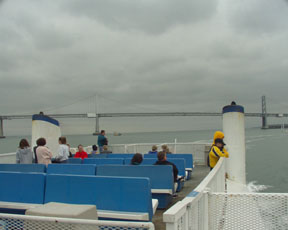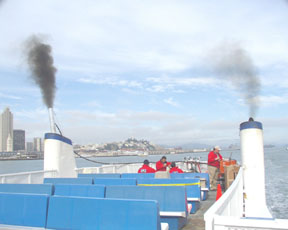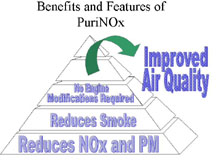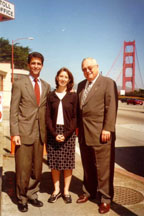|

“Fill and Go”
First Passenger Ferry in North
America Tested with Water Blended Fuel
 |
| Clean smoke
stacks, on Golden Gate Ferry Running on PuriNOx,™ fuel |
A mechanic would typically recommend that drivers
not get water in their fuel line. Yet, that’s exactly what the
Golden Gate Bridge, Highway and Transit District has deliberately
chosen to do in its Golden Gate Ferry. The WTA partnered with GGBHTD,
the agency that operates the Golden Gate Ferry Fleet, for a
first-time-ever demonstration project to test PuriNOx™ fuel, a
blend of diesel fuel and water, on the MV Golden Gate for three
weeks on its run from Sausalito to San Francisco.
 |
| Visible
ferry emissions from ferry powered by regular diesel. |
“The WTA is particularly excited about
fill-and-go technologies, such as PuriNOx™ fuel and biodiesel,
that could be used quickly without the need for costly engine
modifications. Although more expensive than traditional diesel, the
cost of PuriNOx,™ fuel is a practical, affordable option for
existing vessels looking to reduce diesel emissions,” said Mary
Culnane, WTA Manager of Marine Engineering.
David Clark, GGBHTD’s Ferry Division Manager said, “The District
is committed to assisting the WTA by cooperating on this project by
testing PuriNOx,™ fuel on ferries. This is a unique opportunity
for us to help collect data that will be included in the WTA’s
regional plan for ferry expansion.”
Cutting Through the Haze
 |
| Benefits of
PuriNOx™ fuel |
Almost five years ago Lubrizol Corporation, a
Cleveland based corporation, teamed up with Caterpillar, Inc. to
develop PuriNOx,™ fuel. Lubrizol is a $1.8 billion corporation
specializing in high performance chemical, systems and services.
Caterpillar provided the engine know-how and Lubrizol the chemical
knowledge. Out of the partnership an engine-friendly and
cost-favorable fuel was born. The fuel has been evaluated in
environmentally sensitive areas such as in California on both
highway and non-highway diesel engine equipment.
Because PuriNOx,™ fuel requires no hardware add-ons or engine
modifications, it is known as “fill-and-go” technology and is
easy to implement. PuriNOx,™ fuel is especially useful for older,
high-mileage engines that tend to “smoke” using traditional
diesel. PuriNOx,™ fuel is composed of 20% water, 77% diesel and
the 3% additive developed by Lubirzol to bind the water and diesel.
The water lowers the combustion temperature and modifies the
combustion process to reduce smog-creating compounds.
“The State of California has shown confidence in PuriNOx’s™
technology effectiveness as a clean diesel fuel,” said Bill
Hagstrand, Lubrizol’s marketing manager for the West Cost. “The
California Air Resources Board (CARB) verified the emissions
benefits of this technology with data showing reduction in
particulate matter of 63% and 14% in NOx. A big boost came when
California recently approved a reduction in the excise fuel tax for
on-road users of PuriNOx™ fuel,” added Hagstrand.”
Some successful examples of PuriNOx™ fuel
include:
 | Salt Mine Equipment — In Cleveland, PuriNOx™
fuel is being used to power underground equipment used for
mining salt for roads; it is important to lower emissions in
these salt mines to protect workers’ health. |
 | Marine Terminals — The Port of Houston is
using PuriNOx™ fuel on its mechanical cranes and dock
equipment. PuriNOx™ fuel was picked by the Port as an
affordable and practical option to improve Houston’s severe
air quality problems. |
 | Cement Trucks — A Port of San Francisco
tenant has used PuriNOx™ fuel to fuel its cement trucks for
two years. The Port’s Maritime/Industrial policy encourages
tenants to use cleaner fuel like PuriNOx™ fuel by giving them
credits toward rent. |
 | Bus Fleets — In Antioch, the Tri Delta
Transit, a bus fleet has been utilizing PuriNOx™ fuel over the
past 8˝ months, it successfully tested sixteen out of its fleet
of seventy-two passenger buses. |
 |
| PuriNOx™
fuel resembles skim milk |
Although not originally designed for marine applications, the WTA
and GGBHTD decided that the opportunity to test this fuel should not
be lost. Lubrizol’s long list of references was very important to
the GGBHTD’s considering this test project. Caterpillar Engine
Company extended the MV Golden Gate’s engine warranty to PuriNOx™
fuel, which was critical to closing this deal. The WTA is providing
funding to cover the costs differences of this fuel.
Al Boro, Mayor of San Rafael, WTA Board and GGBHTD Board Member, is
very enthusiastic about this project: “I’m proud to serve on the
boards of two agencies that are gathering the information needed to
improve our future environment.”
Before fueling the MV Golden Gate with this clean diesel, the WTA’s
air quality consultants took baseline emissions data and will
perform emission testing while the ferryboat is operating on PuriNOx™
fuel in order to substantiate the emission reduction. The results
will be evaluated in May along with how the boat performed while on
PuriNOx™ fuel and any mechanical issues that arose with its use.
Commuters Want Clean Transit Options
A recent public opinion survey commissioned by the
WTA indicated that 71 percent of those questioned would prefer
taking a mode of transit that is good for the environment. Taking
steps to decrease the adverse air quality effects from public
transit doubles this benefit.
Recognizing that commuters support an enhanced, clean public
transportation system, GGBHTD evaluated the nation’s first
methanol powered buses from 1983 to 1989. This project study noted
remarkable reductions in particulate matter and other emissions.
Unfortunately, because of high costs methanol was not considered a
viable fuel at that time. Currently, GGBHTD and AC Transit are
working out the details of a Zero Emission Bus Demonstration Project
that includes the purchase and operation of up to six hydrogen fuel
cell powered buses.
Supervisor Mark Leno, San Francisco’s representative on the GGBHTD,
recently expressed his support for public transportation
demonstration projects testing low-emission fuels. “The WTA’s
commitment to research and development in the area of alternative
and low-emission fuels will forge the path nationwide for a cleaner
fleet of marine vessels,” Leno predicted. Leno sponsored a
successful bond measure last November seeking voter approval to pay
for installing solar panels and wind machines in San Francisco.
“We have taken the California Legislature’s directive to examine
the feasibility or new fuel and propulsion technologies seriously,”
said Tom Bertken, the WTA’s Chief Executive Officer. “The WTA’s
demonstration projects over the past year include soybean biodiesel,
fuel cells, clean diesel and continuous water injection. We need
options that will reduce emissions cost effectively, “ added
Bertken.
WTA’s Clean Fuels and Tech Report Ready in
May.
This technical working paper will provide a
glimpse of new propulsion and alternative fuel options for future
ferryboats. This work will be of great interest when the WTA’s
plan for expansion of ferries is released this upcoming Fall. |
Bay Commuters Can Spare the
Air by Participating in Bike to Work Day
|

|
| Golden
Gate Bridge Highway and Transit District Directors: San
Francisco Supervisor Mark Leno, SF Bicycle Coalition
Program Director Leah Shahum, and Mayor of San Rafael
Albert Boro. |
On May 16, hundreds of workers will hop on their
bikes and pedal to work. Bike to Work Day, now in its 8th year,
continues to gain popularity with Bay Area residents eager to
reduce traffic congestion, save the environment, and stay healthy
by biking to the office. Commuters crossing the Bay to work needn’t
feel left out because the ferry system presents the perfect
opportunity for individuals to grab their bikes, ride down to the
shoreline, drift across the Bay and continue on to their
destinations.
 |
| Biking to
work across the Bay is easy with a little help from a ferry. |
Ferry operators have long recognized the
importance of using bicycles to connect people to alternative
transit modes. Racks are installed on ferries so that bicycles are
safely stashed or, if preferred, bikes can be stored in lockers at
certain terminals. Staff is always happy to help bicyclists with
boarding and exiting boats. Faced with parking limitations,
commuters must examine other ways of getting to ferry terminals,
whether it be by walking, biking, bus, light rail, or BART. Often
times biking provides the quickest, most direct route to a
terminal. In San Francisco alone 25,000 to 30,000 folks use their
bikes regularly for work, shopping and recreation. On Bike to Work
Day, this number increases by the thousands.
“Integrating various modes of transportation
builds momentum toward a society no longer reliant on automobiles.
Using bicycles as a way to connect to ferries supports a clean,
healthy commute environment,” commented Leah Shahum, SF Bicycle
Coalition Program Director and GGBHTD Board Member.
For more information on Bike to Work Day, or to
request a free San Francisco bike maps and safety pamphlets, call
the San Francisco Bicycle Coalition information line at (415)
585-BIKE or visit www.sfbike.org. |